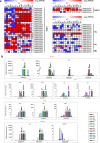Genome-wide identification of MADS-box gene family in sacred lotus (Nelumbo nucifera) identifies a SEPALLATA homolog gene involved in floral development
- PMID: 33121437
- PMCID: PMC7599106
- DOI: 10.1186/s12870-020-02712-w
Genome-wide identification of MADS-box gene family in sacred lotus (Nelumbo nucifera) identifies a SEPALLATA homolog gene involved in floral development
Abstract
Background: Sacred lotus (Nelumbo nucifera) is a vital perennial aquatic ornamental plant. Its flower shape determines the horticultural and ornamental values. However, the mechanisms underlying lotus flower development are still elusive. MADS-box transcription factors are crucial in various features of plant development, especially in floral organogenesis and specification. It is still unknown how the MADS-box transcription factors regulate the floral organogenesis in lotus.
Results: To obtain a comprehensive insight into the functions of MADS-box genes in sacred lotus flower development, we systematically characterized members of this gene family based on the available genome information. A total of 44 MADS-box genes were identified, of which 16 type I and 28 type II genes were categorized based on the phylogenetic analysis. Furthermore, the structure of MADS-box genes and their expressional patterns were also systematically analyzed. Additionally, subcellular localization analysis showed that they are mainly localized in the nucleus, of which a SEPALLATA3 (SEP3) homolog NnMADS14 was proven to be involved in the floral organogenesis.
Conclusion: These results provide some fundamental information about the MADS-box gene family and their functions, which might be helpful in not only understanding the mechanisms of floral organogenesis but also breeding of high ornamental value cultivars in lotus.
Keywords: Floral organogenesis; Genome-wide analysis; Lotus; MADS-box; SEP3.
Conflict of interest statement
The authors declare that they have no competing interests.
Figures







Similar articles
-
Transcriptomic analysis identifies the key genes involved in stamen petaloid in lotus (Nelumbo nucifera).BMC Genomics. 2018 Jul 27;19(1):554. doi: 10.1186/s12864-018-4950-0. BMC Genomics. 2018. PMID: 30053802 Free PMC article.
-
Identification and characterization of two APETALA2 homolog genes in lotus (Nelumbo nucifera) involved in sepal and petal development.BMC Plant Biol. 2024 Dec 18;24(1):1186. doi: 10.1186/s12870-024-05923-7. BMC Plant Biol. 2024. PMID: 39695956 Free PMC article.
-
Target genes of the MADS transcription factor SEPALLATA3: integration of developmental and hormonal pathways in the Arabidopsis flower.PLoS Biol. 2009 Apr 21;7(4):e1000090. doi: 10.1371/journal.pbio.1000090. PLoS Biol. 2009. PMID: 19385720 Free PMC article.
-
Dissecting the role of MADS-box genes in monocot floral development and diversity.J Exp Bot. 2018 Apr 27;69(10):2435-2459. doi: 10.1093/jxb/ery086. J Exp Bot. 2018. PMID: 29718461 Review.
-
MADS-box genes and floral development: the dark side.J Exp Bot. 2012 Sep;63(15):5397-404. doi: 10.1093/jxb/ers233. Epub 2012 Aug 21. J Exp Bot. 2012. PMID: 22915743 Review.
Cited by
-
Genome-wide identification and expression pattern analysis of MIKC-Type MADS-box genes in Chionanthus retusus, an androdioecy plant.BMC Genomics. 2024 Jul 2;25(1):662. doi: 10.1186/s12864-024-10569-8. BMC Genomics. 2024. PMID: 38956488 Free PMC article.
-
Comprehensive Analysis for GRF Transcription Factors in Sacred Lotus (Nelumbo nucifera).Int J Mol Sci. 2022 Jun 15;23(12):6673. doi: 10.3390/ijms23126673. Int J Mol Sci. 2022. PMID: 35743113 Free PMC article. Review.
-
Genome-Wide Identification and Co-Expression Networks of WOX Gene Family in Nelumbo nucifera.Plants (Basel). 2024 Mar 4;13(5):720. doi: 10.3390/plants13050720. Plants (Basel). 2024. PMID: 38475567 Free PMC article.
-
SEP-like genes of Gossypium hirsutum promote flowering via targeting different loci in a concentration-dependent manner.Front Plant Sci. 2022 Dec 1;13:990221. doi: 10.3389/fpls.2022.990221. eCollection 2022. Front Plant Sci. 2022. PMID: 36531379 Free PMC article.
-
Genome-Wide Identified MADS-Box Genes in Prunus campanulata 'Plena' and Theirs Roles in Double-Flower Development.Plants (Basel). 2023 Sep 4;12(17):3171. doi: 10.3390/plants12173171. Plants (Basel). 2023. PMID: 37687417 Free PMC article.
References
-
- Wang Q, Zhang X. Colored illustration of lotus cultivars in China. Beijing: China Forestry Publishing House; 2005.
-
- Kubo N, Hirai M, Kaneko A, Tanaka D, Kasumi K. Development and characterization of simple sequence repeat (SSR) markers in the water lotus (Nelumbo nucifera) Aquat Bot. 2009;90(2):191–194. doi: 10.1016/j.aquabot.2008.06.006. - DOI
-
- Shen-Miller J. Sacred lotus, the long-living fruits of China antique. Seed Sci Res. 2007;12(3):131–143. doi: 10.1079/SSR2002112. - DOI
MeSH terms
Substances
LinkOut - more resources
Full Text Sources

